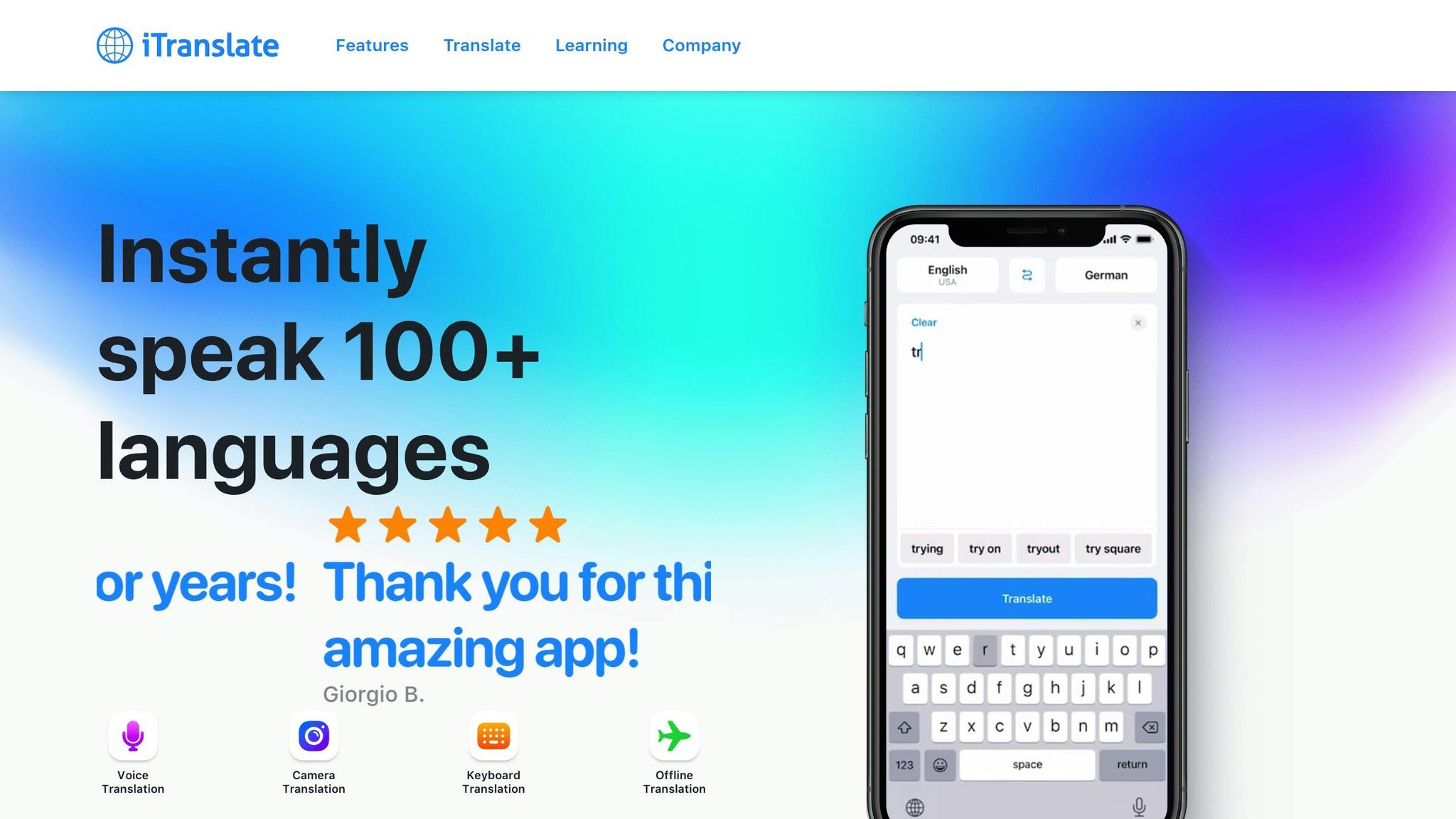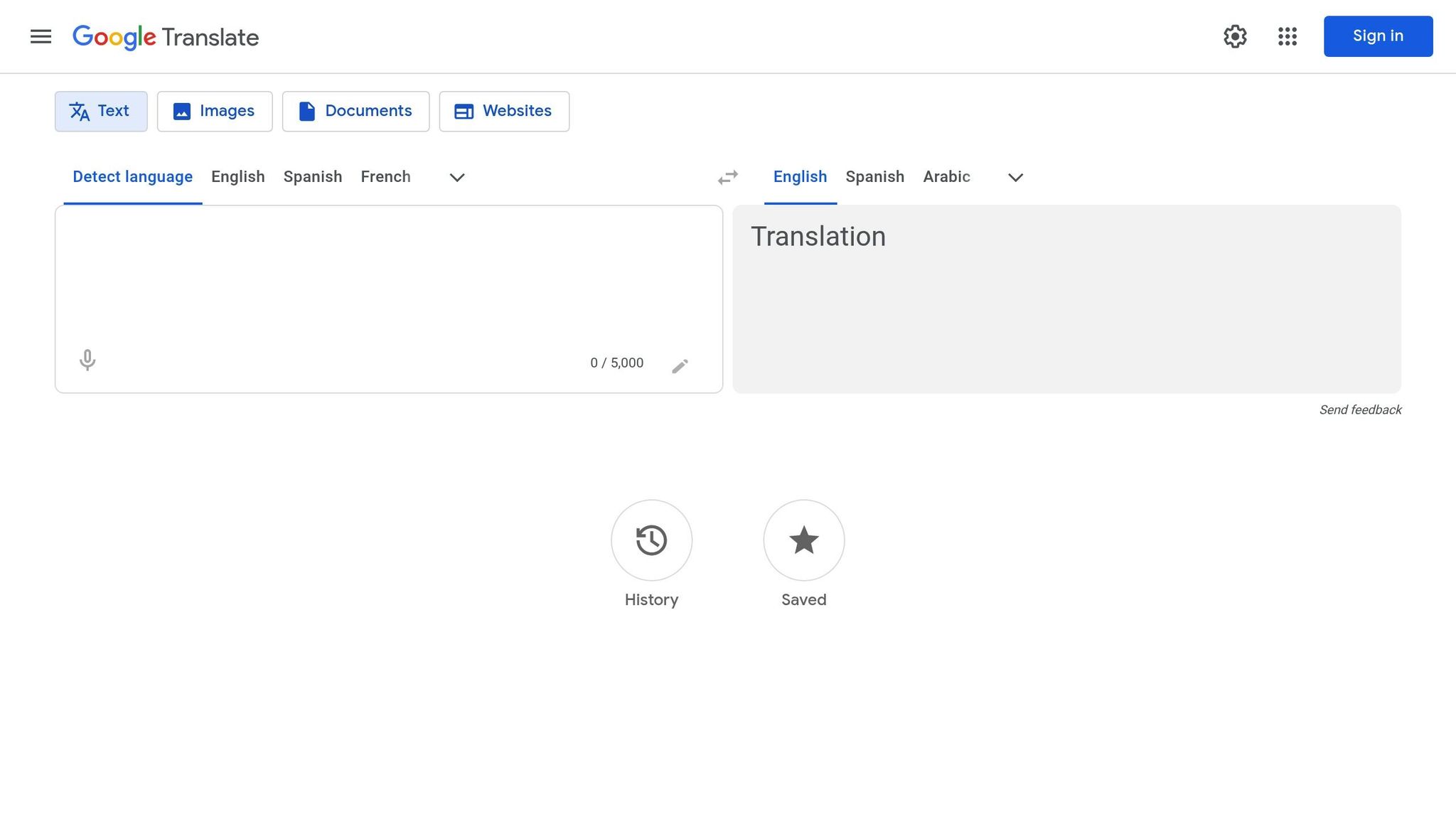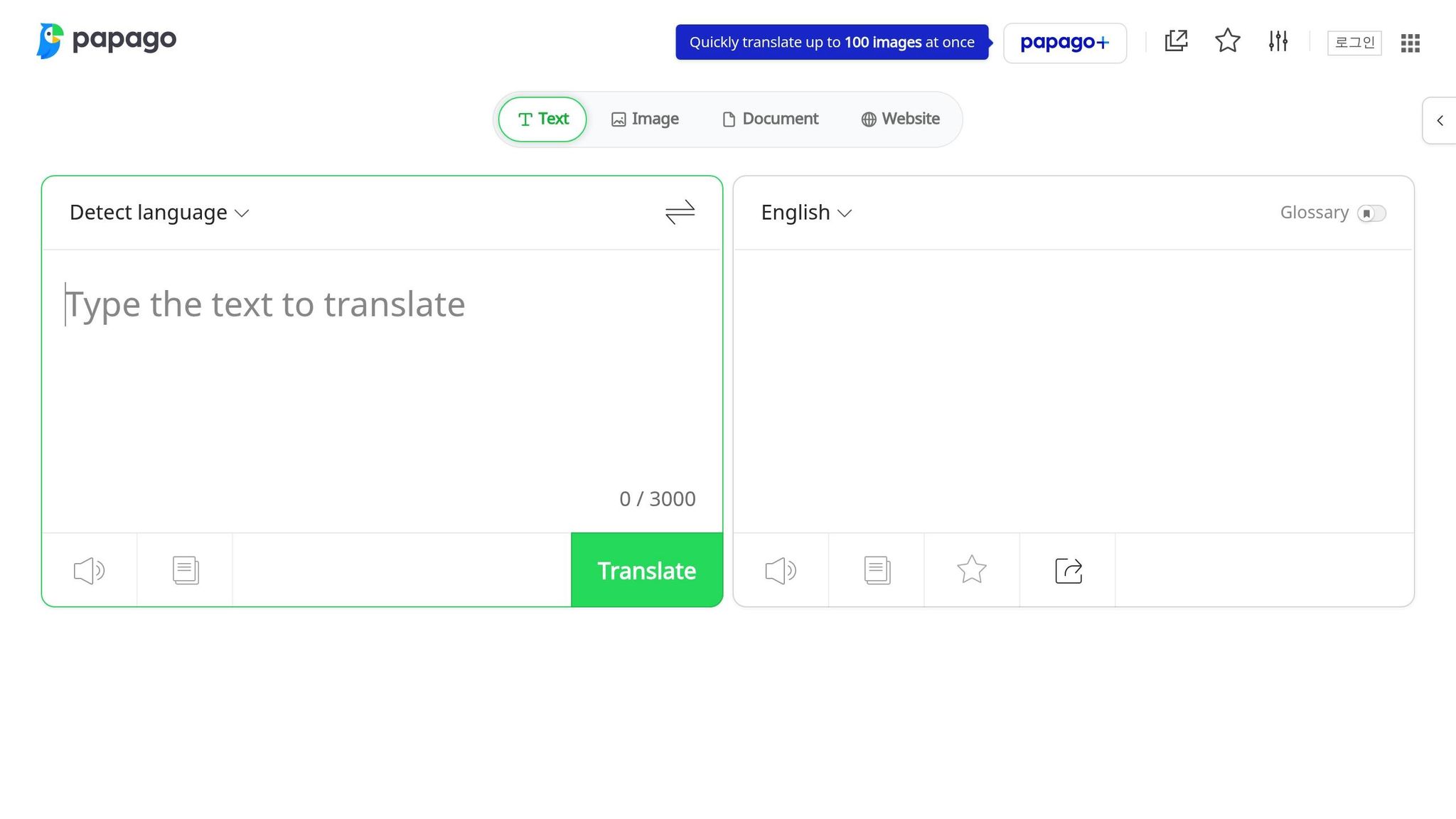Top 7 Offline Voice-to-Text Apps for Translation
Offline voice-to-text translation apps are essential for travelers, professionals, and anyone navigating areas with limited internet access. These tools convert spoken words into text and translate them into various languages – all without requiring a connection. Here’s a quick overview of the top options:
- iTranslate Offline: Supports 40+ offline languages, voice options, and photo translation. Pro version costs $5.99/month.
- Google Translate Offline: Covers 59 offline languages, includes camera translation, and is free.
- Microsoft Translator: Offers 70+ offline languages, real-time conversation translation, and is free.
- Naver Papago: Focused on Asian languages like Korean, Japanese, and Chinese. Free with 13 offline languages.
- Lingvanex Translator: Provides 91 offline languages, voice-to-text in 93 languages, and strong privacy features.
- Wooask: Translates 8 offline languages (16 with its W12 device), with Bluetooth earphone compatibility.
- Speak & Translate: Handles 54 offline voice languages and 117 text languages. Premium version required.
Quick Comparison
| App | Offline Languages | Key Features | Cost |
|---|---|---|---|
| iTranslate | 40+ | Photo translation, voice options | $5.99/month |
| Google Translate | 59 | Camera translation, free to use | Free |
| Microsoft Translator | 70+ | Group conversations, visual translation | Free |
| Naver Papago | 13 (Asian focus) | Contextual translations for Korean | Free |
| Lingvanex Translator | 91 | Voice-to-text, data privacy | Free |
| Wooask | 8 (16 with device) | Bluetooth earphone compatibility | Device purchase needed |
| Speak & Translate | 54 (voice), 117 (text) | Dictionary mode, paragraph translation | Premium version needed |
Key Takeaways
- For broad language support, try Google Translate or Microsoft Translator.
- For Asian languages, Naver Papago excels.
- For privacy-conscious users, Lingvanex Translator is a solid choice.
- If you need Bluetooth earphone integration, explore Wooask.
Offline translation apps are practical tools for seamless communication, especially in areas with poor connectivity. Choose the one that fits your needs, download language packs ahead of time, and enjoy smoother interactions wherever you go.
10 Best Offline Translator Apps for Android and iOS in 2025
1. iTranslate Offline

With over 150 million downloads, iTranslate has established itself as a popular choice for translation needs. Its offline capabilities make it a handy tool for travelers and those needing quick translations without internet access.
The app supports offline translation in 40+ languages and can convert spoken words into text seamlessly. Here’s a quick breakdown of its standout features:
| Feature | Description |
|---|---|
| Language Support | Offers offline translation for 40+ languages and over 100 languages online |
| Voice Options | Includes multiple voices and dialects for natural pronunciation |
| Platform Availability | Compatible with both iOS and Android devices |
| Additional Tools | Features like camera translation and a keyboard extension |
While the basic version is free, upgrading to the Pro subscription unlocks extra benefits, including:
- Advanced offline translation tools
- Photo translation for visual text
- More voice options and dialects for enhanced accuracy
iTranslate has earned solid ratings across platforms, with a 3.4-star rating on Google Play from 399,000 reviews. For Android users, it holds a slightly higher 3.8-star rating, reflecting consistent user satisfaction.
One standout feature is its voice output, which ensures accurate pronunciation and smoother communication. Whether you’re navigating a foreign country or learning a new language, iTranslate aims to make the process easier and more accessible.
2. Google Translate Offline

Google Translate offers dependable offline voice-to-text translations, making it a handy tool when you’re without internet access.
| Feature | Details |
|---|---|
| Download Options | Choose to download language packs via Wi-Fi or mobile data. |
| Storage | Manage space by updating or deleting individual language packs. |
| Accessibility | Use the camera feature to translate visual text. |
| Updates | Frequent updates to language packs improve translation quality. |
Here’s how to set up offline translation:
- Download Language Packs: While connected to the internet, tap the download icon next to the languages you need.
- Manage Languages: Keep an eye on your storage and update or delete language packs as necessary.
- Control Data Usage: Decide whether to download language packs over Wi-Fi or mobile data, depending on your preference.
Switching between online and offline modes is seamless, thanks to the app’s intuitive interface. When offline, translations are processed directly on your device, ensuring smooth and consistent functionality.
Additionally, the camera translation feature works offline if you’ve downloaded the necessary language packs. This is particularly useful for translating signs, menus, or documents during your travels, all without needing an internet connection.
3. Microsoft Translator
Microsoft Translator is a handy tool for translating voice to text, even when you’re offline. Designed for personal, business, and educational use, it’s part of Azure AI Services and supports offline functionality through downloadable language packs.
| Feature | Description |
|---|---|
| Offline Mode | Use downloaded language packs without the internet |
| Voice Recognition | Translate conversations in real time |
| Visual Translation | Translate text from menus, signs, and more |
| Device Compatibility | Works on iOS, Android, and Windows devices |
This app processes spoken words directly on your device, allowing for smooth, natural conversations even when you’re offline. Its visual translation tool is equally impressive, letting you snap a photo of text – like a menu or a street sign – and translate it instantly, no connection needed.
Thanks to its offline language packs, Microsoft Translator ensures you’re never stranded without translation help, even in areas with poor connectivity.
4. Naver Papago

Naver Papago is a voice-to-text translation app tailored for Asian languages, with a strong focus on Korean. One of its standout features is its offline mode, which allows for dependable translations even when you’re not connected to the internet.
| Feature | Details |
|---|---|
| Offline Languages | English, Korean, Chinese, Japanese |
| Total Languages | 14, including Spanish, French, Vietnamese, Thai, Indonesian, Russian, German, Italian, and Arabic |
| Special Features | Recognizes Korean dialects, offers contextual translations |
| Cost | Free |
What sets Papago apart is its ability to accurately understand Korean dialects and deliver translations that feel natural and contextually appropriate. This is especially important for languages with unique grammatical structures. You can download language packs for its main offline languages, ensuring you’re covered for essential East Asian languages, even without internet access. While the offline mode supports fewer languages than the online version, it still covers all the critical bases for everyday use.
With its thoughtful features and reliable offline functionality, Papago is a go-to tool for travelers and professionals navigating the region.
sbb-itb-32359dc
5. Lingvanex Translator

Lingvanex Translator is a solid choice for offline voice-to-text translation. With over 500,000 downloads and a 3.8-star rating from 2,550 reviews, it has gained attention for its reliability even when you’re not connected to the internet.
| Feature | Details |
|---|---|
| Offline Languages | Offers 91 languages for offline use |
| Voice Features | Speech-to-text in 93 languages, plus voice-over translation |
| Platform Support | Available on iOS, Android, Windows, and macOS |
| Security | Uses secure servers, no third-party data sharing |
The app’s wide range of language packs and compatibility across multiple platforms – iOS, Android, Windows, and macOS – make it a practical tool for various needs. Plus, all translations are processed on secure servers, ensuring your personal data stays private and isn’t shared with third parties. This focus on security makes it a trustworthy option for users concerned about data protection.
With its combination of versatility, extensive language options, and strong privacy measures, Lingvanex is a dependable tool for both personal and professional use.
Next, let’s dive into a detailed comparison of the standout features across these top apps.
6. Wooask

Wooask delivers high-accuracy offline voice-to-text translation through its mobile app and dedicated hardware. The app provides real-time translation in 8 languages (including Chinese, English, Japanese, Korean, Russian, German, French, and Spanish), while the W12 device extends this capability to 16 languages.
| Feature | Details |
|---|---|
| Offline Languages | 8 languages (app) / 16 languages (W12 device) |
| Translation Speed | 0.5-second response time |
| Claimed Accuracy | 97–98% for basic phrases |
| Latest Update | March 14, 2025 |
| Additional Features | Bluetooth earphone compatibility and photo translation |
One of Wooask’s standout features is its ability to transform standard Bluetooth earphones into translation tools. The platform integrates with the A8 TransBuds, which come equipped with Enhanced Noise Cancellation for clearer audio. These earbuds are unique because they function independently, without needing to connect to a smartphone or rely on apps.
"The A8 is currently the only standalone translation earbud on the market that does not require a connection to a phone or any apps. It operates fully independently, allowing you to access translations and features without any additional devices." – WOOASK
While these features are promising, user feedback has been mixed. In January 2025, an Amazon Vine reviewer highlighted the device’s impressive performance during travel. However, some users noted occasional inaccuracies in offline translations.
7. Speak & Translate
Speak & Translate is a handy tool that supports offline voice translation in 54 languages and text translation in 117 languages. To use it offline, simply download the required language packs while connected to the internet.
| Feature | Details |
|---|---|
| Offline Languages | 54 (voice), 117 (text) |
| App Store Rating | 4.6/5 (253.4K ratings) |
| Google Play Rating | 4.5/5 (114K reviews) |
| Key Features | Dictionary mode, paragraph translation |
The app’s performance is well-suited for practical situations. Its voice recognition is most effective when users speak clearly, slowly, and with consistent pronunciation. To ensure the best results, make sure to download the language packs ahead of time.
"It works well; although some words are off, the overall meaning is clear. Speaking slowly enhances accuracy".
However, users with strong accents might need to tweak their speech for better recognition. With its broad language coverage and dependable functionality, Speak & Translate is a great option for travelers and professionals alike.
App Features Comparison
When deciding on the best offline voice-to-text translator, it’s important to weigh the core features of each app. Here’s a quick look at how they stack up:
| Feature | Languages Supported | Offline Capabilities | Key Strengths | Premium Features Cost |
|---|---|---|---|---|
| iTranslate | 40+ languages | Full offline support | Includes a phrasebook with 250+ phrases and a transcript feature | $5.99/month or $49.99/year |
| Google Translate | 100+ online, 59 offline | Partial offline support | Offers image translation and extensive language coverage | Free |
| Microsoft Translator | 70+ languages | Partial offline support | Supports group conversations | Free |
| Naver Papago | 13 languages | Full offline for Asian languages | Highly accurate for Korean, Japanese, and Chinese | Free |
| Speak & Translate | 54 voice, 117 text | Full offline with downloads | Features dictionary mode and paragraph translation | Premium version required |
Key Considerations and Insights
Each app has its strengths, but there are a few technical and practical factors to keep in mind:
- Storage Requirements: Downloading language packs will take up 50–150MB per pack. Make sure your device has enough storage space.
- Device Compatibility: These apps work best on devices running iOS 13+ or Android 8.0+.
- Performance Factors: Battery consumption, ambient noise, and device proximity to the sound source can all impact accuracy and usability.
For specific needs, here’s how the apps compare:
- Naver Papago: If you’re translating Asian languages like Korean, Japanese, or Chinese, this app stands out for its accuracy.
- Google Translate: Ideal for broad language support, especially if you need a free option. However, offline functionality is somewhat limited.
- iTranslate: Offers robust offline features, but these come at a premium price.
Tips for Better Results
Making the most of these apps often comes down to how you use them. Here are a few tips:
- Speak clearly and download necessary language packs in advance.
- Use the app in quiet environments to improve recognition accuracy.
- Keep your device close to the sound source for better performance.
Ultimately, the right choice depends on your priorities. If you need free, broad language coverage, Google Translate is a solid pick. For Asian languages, Naver Papago is unmatched. If offline functionality is a must, iTranslate delivers, though it comes with a subscription cost.
Final Thoughts
Offline voice-to-text translation apps have become a go-to solution for bridging language gaps when there’s no internet access. For travelers and professionals working in areas with limited connectivity, choosing the right app can make all the difference in successful communication.
Based on the features we’ve discussed, here are some tailored recommendations for specific travel needs:
- Asian Language Translation: If you’re navigating Korean, Japanese, or Chinese, Naver Papago stands out for its offline accuracy.
- Global Coverage: Google Translate offers dependable offline translations across a wide range of languages and regions.
- Business Travel: For professionals on the move, Microsoft Translator delivers the reliability you need for offline communication.
While these apps already meet most needs, technology is evolving rapidly. Emerging tools like Meta’s SeamlessM4T and Microsoft’s VALL-E are set to push offline translation to the next level:
- Meta’s SeamlessM4T integrates speech recognition, translation, and text-to-speech into a single streamlined process.
- Microsoft’s VALL-E can replicate a speaker’s voice using just a short audio clip.
These advancements promise even more accurate, natural translations, further enhancing the experience for travelers and professionals alike.
Essential Tips
Before you head out, keep these tips in mind:
- Download language packs: Make sure to install the necessary offline language packs and test them ahead of time.
- Test for accuracy: Try translating a few key phrases in your destination’s language to ensure the app performs as expected.
As AI continues to evolve, offline voice-to-text translation will only get better. Future updates will likely tackle complex phrases, regional accents, and conversational subtleties, making these tools even more reliable for seamless global communication.
FAQs
How do offline voice-to-text translation apps work without an internet connection?
Offline voice-to-text translation apps operate using pre-trained machine learning models stored right on your device. These models are built to handle speech processing in real-time, meaning they can work seamlessly without needing an internet connection.
To deliver accurate results, these apps typically come with offline language packs and fine-tuned algorithms for the supported languages. This approach not only boosts privacy and minimizes lag but also ensures dependable performance, no matter where you are.
What should I look for in an offline voice-to-text translation app for my language needs?
When choosing an offline voice-to-text translation app, prioritize how accurately it translates and whether it supports the languages you need. Language availability varies between apps, so double-check that your target languages are included.
You’ll also want to think about the app’s ease of use. Look for features like simple controls, offline capabilities, and whether it works seamlessly with your device. These elements can make the app more convenient and reliable for your specific needs.
What are the main drawbacks of using offline voice-to-text translation apps?
Offline voice-to-text translation apps come with certain drawbacks when compared to their online counterparts. Because they depend on preloaded language data, their accuracy can diminish over time, especially when it comes to keeping up with evolving slang, idiomatic expressions, or newly introduced phrases. They also miss out on the benefits of real-time updates and cloud-based processing, which can limit their ability to handle more intricate or rapidly changing translations.
While these apps are handy for situations where an internet connection isn’t available, their functionality tends to be more static. This often means they lack the adaptability and precision found in online tools. For users who need the latest translations or more advanced features, this trade-off can be a noticeable limitation.


